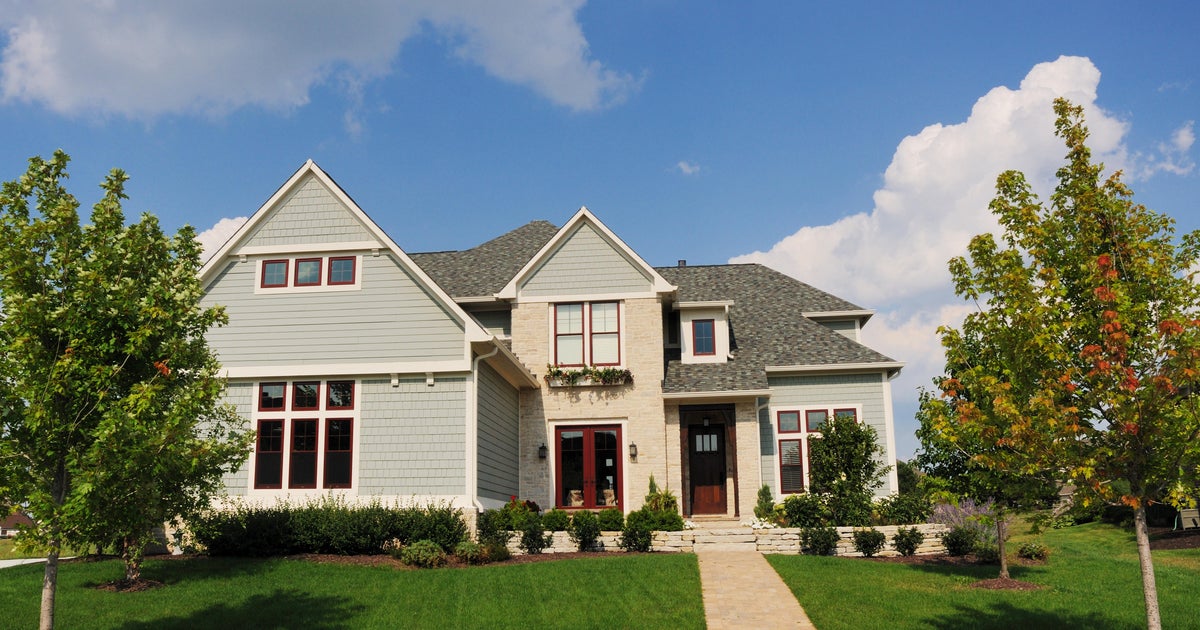CBS News
Families sacrifice time and money caring for loved ones. A new caregiver calculator reveals the high cost.

Across the U.S., family members caring for loved ones provide an estimated $600 billion in unpaid services each year, sacrificing time, money and often their well-being to care for aging loved ones, according to an AARP survey.
As Congress considers a bill that would provide family caregivers a tax credit, quantifying how much that time is worth is proving to be difficult.
Amy Goyer understands the challenge. Caring for her aging parents meant turning her life upside down. Her mother had a stroke in her late 60s and her father was diagnosed with Alzheimer’s disease.
Family caregivers face a financial toll
Pictures line the walls of Goyer’s home in Chandler, Arizona. They’re filled with memories of a lifetime that became a source of stress and financial strain. As a caregiver for her parents, she had to pay for renovations to safety-proof her home. She also lost money and time when she could have been working more to care for her parents.
CBS News
“It was financially devastating for me,” Goyer said. “I don’t have regrets about anything I did in caring for my family, but I ended up in bankruptcy after my dad passed away.”
Goyer, also a caregiving expert for AARP with more than 35 years of experience, was not immune to the financial strain of caring for her parents.
“How are you supposed to take care of yourself, your family and your home when you’re working two jobs — one paid and one unpaid for your loved ones?” she asked.
The burden Goyer faced is becoming more common across America. According to a Harvard Business School report, 73% of American workers surveyed provide some type of caregiving at home.
Calculating the cost
Shon Lowe has been caring for her mother, Terrie Montgomery, since her Alzheimer’s diagnosis a decade ago.
CBS News
The financial toll on families can be high. AARP calculated family caregivers spend an average $7,242 of their own money each year, according to a 2021 survey. That doesn’t include the time they spend taking care of things, such as managing medication, finances and food prep.
Salary.com and Otsuka Pharmaceuticals, maker of medications for neurological disorders like dementia, said they created a new tool, which offers a clearer picture of the financial cost of caregiving. The cost is often hidden but felt deeply by families everywhere.
Lowe tried the Family Caregiver Calculator, which calculates the financial value of caregiving based on geography, time spent, and the type of work done for family caregivers. When she entered the hours she and her siblings spend caring for their mother, the result was $270,103 per year.
“It’s unbelievable,” Lowe said. “Something should be done about that.”
CBS News
Financial help is available for families
The creators of the Family Caregiver Calculator hope to urge policymakers to pass legislation, which supports unpaid family caregivers and help families budget for caregiving expenses.
“We largely don’t have enough support,” said Amy Goyer.
She added that without more resources, the financial burden will only grow for future generations.
“We’re putting our caregivers’ financial security in jeopardy,” she said. “They’re not going to have the money to pay for someone to care for them.”
While some states have programs that allow family caregivers to receive compensation, Goyer explained these opportunities are limited.
A recent report to Congress by the Recognize, Assist, Include, Support and Engage (RAISE) Family Caregiving Council proposed several potential solutions to ease this burden, including a federal tax credit for family caregivers, immigration reform to expand the caregiver workforce, and expanding grant programs for states.
These solutions offer hope to families struggling under the burden of caregiving but require congressional action. If passed, the Credit for Caring Act, introduced in Congress this year, would provide a federal tax credit of up to $5,000 to qualifying caregivers.
AARP is advocating for the passage of this bill, stressing it would bring much-needed relief to caregivers who are often financially stretched while caring for their loved ones.
Without financial help, Goyer said families end up passing down debt from one generation to the next.
“What we’re doing is we’re putting the financial security of our caregivers in jeopardy in the future,” Goyer said. “So they’re not going to have the money to pay for somebody to take care of them.”
contributed to this report.
CBS News
80 people sick after attending LA Times food tasting festival

Painful cramps, nausea and vomiting were some of the symptoms some attendees experienced after attending a food festival held to celebrate Southern California’s best restaurants.
Mark Kapczynski was one of the 80 people who became sick after a norovirus outbreak.
“It was pretty painful, probably the most painful experience I have ever had,” he said.
Kapczynski is still recovering from catching the highly contagious stomach bug at a place he never expected.
“Certainly never thought it was the 101 event — these restaurants are too good couldn’t possibly be that,” he said.
Kapczynski said he and his wife attended the Los Angeles times 101 Best Restaurants event earlier this month, a food-tasting festival celebrating what the newspaper’s editors rank are the 101 best places to eat in Southern California.
“We visited Providence, which I mean they are a world-class restaurant serving fresh oysters and clams with different sauces and I ended up having two plates very quickly,” Kapczynski said.
Kapczynski said he felt bloated immediately after eating the oysters. By the next day, his symptoms got worse.
“The abdomen pain has just had just had me curled up in a ball and tremendous chills — just couldn’t get comfortable,” he said.
Kapczynski isn’t the only one who got sick from eating oysters. The LA County Department of Public Health is now investigating a norovirus outbreak. So far, they have identified 80 cases. Emergency room physician Dr. Ali Jamehdor said the illness isn’t a typical stomach bug.
“Oysters seem to really hit patients hard when they come into the ER they’re very, very ill,” he said. “Vomiting, diarrhea, significant abdominal cramping and it’s all due to a bug called vibrio. It’s a very specific bacteria that’s specific to oysters and causes an illness that hits people very, very hard.”
Providence, one of LA’s most celebrated restaurants said the oysters came from farms near Vancouver, British Columbia, Canada. Health inspectors at the event signed off on all handling and serving regulations.
“The nature of norovirus is such that it would be undetectable to the vendor, the restaurant or the health inspectors who were onsite given that norovirus does not affect the appearance, odor or flavor of the shellfish,” the restaurant wrote in a statement.
The California Department of Public Health issued a statewide alert on Canadian oysters 10 days after the event. The warning said the shellfish could make people sick.
KCAL News reached out to the LA Times but has not heard back yet. The FDA says people infected with the virus can experience symptoms for 12 to 48 hours.
CBS News
Thousands of Jews have left leave Israel since the October 7 attacks

Leaving Israel is easier, Shira Z. Carmel thinks, by saying it’s just for now. But she knows better.
For the Israeli-born singer and an increasing number of relatively well-off Israelis, the Oct. 7, 2023 Hamas attack shattered any sense of safety and along with it, Israel’s founding promise: to be the world’s safe haven for Jews. That day, thousands of Hamas militants blew past the country’s border defenses, killed 1,200 Israelis and dragged 250 more into Gaza in a siege that caught the Israeli army by surprise and stunned a nation that prides itself on its military prowess. This time, during what became known as Israel’s 9/11, the army didn’t come for hours.
Ten days later, a pregnant Carmel, her husband and their toddler boarded a flight to Australia, which was looking for people in her husband’s profession. And they spun the explanation to friends and family as something other than permanent – “relocation” is the easier-to-swallow term – acutely aware of the familial strain and the shame that have shadowed Israelis who leave for good.
“We told them we’re going to get out of the line of fire for awhile,” Carmel said more than a year later from her family’s new home in Melbourne. “It wasn’t a hard decision. But it was very hard to talk to them about it. It was even hard to admit it to ourselves.”
Thousands of Israelis have left the country since Oct. 7, 2023, according to government statistics and immigration tallies released by destination countries such as Canada and Germany. There’s concern about whether it will drive a “brain drain” in sectors like medicine and tech. Migration experts say it’s possible people leaving Israel will surpass the number of immigrants to Israel in 2024, according to Sergio DellaPergola, a statistician and professor emeritus of Hebrew University in Jerusalem.
Thousands of Israelis have opted to pay the financial, emotional and social costs of moving out since the Oct. 7 attack, according to government statistics and families who spoke to The Associated Press in recent months after emigrating to Canada, Spain and Australia.
Israel’s population continues to grow toward 10 million people. But it’s possible that 2024 ends with more Israelis leaving the country than coming in. That’s even as Israel and Hezbollah reached a fragile ceasefire along the border with Lebanon and Israel and Hamas inch toward a pause in Gaza.
Israel’s Central Bureau of Statistics estimated in September that 40,600 Israelis departed long-term over the first seven months of 2024, a 59% increase over the same period a year earlier, when 25,500 people left. Monthly, 2,200 more people departed this year than in 2023, the bureau reported.
The Israeli Ministry of Immigration and Absorption, which does not deal with people leaving, said more than 33,000 people have moved to Israel since the start of the war, about on par with previous years. The interior minister refused to comment for this story, a spokesperson said.
Other clues, too, point to a notable departure of Israelis since the Oct. 7 attacks. Gil Fire, deputy director of Tel Aviv Sourasky Medical Center, said some of its star specialists with fellowship postings of a few years in other countries began to waver about returning.
“Before the war, they always came back and it was not really considered an option to stay. And during the war, we started to see a change,” he said. “They said to us, ‘We will stay another year, maybe two years, maybe more.'”
Fire says it’s “an issue of concern” enough for him to plan in-person visits with these doctors to try to draw them back to Israel.
Michal Harel, who moved with her husband to Toronto in 2019, said that almost immediately after the attacks, the phone began ringing – with other Israelis seeking advice about moving to Canada. On Nov. 23, 2023, the couple set up a website to help Israelis navigate moving, which can cost at least 100,000 Israeli shekels, or about $28,000, Harel and other Israeli relocation experts said.
Not everyone in Israel can just pack up and move overseas. Many of those who have made the move have foreign passports, jobs at multinational corporations or can work remotely. People in Gaza, where local health officials say more than 45,000 people have been killed, have even less choice. Harel reported that the site has received views from 100,000 unique visitors and 5,000 direct contacts in 2024 alone.
Aliya – the Hebrew term for used for immigration, literally the “ascent” of Jews into Israel – has always been part of the country’s plan. But “yerida” – the term used for leaving the country, literally the “descent” of Jews from Israel to the diaspora, emphatically has not.
A sacred trust and a social contract took root in Israeli society. The terms go – or went – like this: Israeli citizens would serve in the military and pay high taxes. In exchange, the army would keep them safe. Meanwhile, it’s every Jew’s obligation to stay, work and fight for Israel’s survival.
“Emigration was a threat, especially in the early years (when) there were problems of nation-building,” said Ori Yehudai, a professor of Israel studies at Ohio State University and the author of “Leaving Zion,” a history of Israeli emigration. “People still feel they have to justify their decision to move.”
Shira Carmel says she has no doubt about her decision. She’d long objected to Netanyahu’s government’s efforts to overhaul the legal system, and was one of the first women to don the blood-red “Handmaid’s Tale” robes that became a fixture of the the anti-government protests of 2023. She was terrified as a new mom, and a pregnant one, during the Hamas attack. This was not the life she wanted.
Meanwhile, Australia beckoned. Carmel’s brother had lived there for two decades. The couple had the equivalent of a green card due to Carmel’s husband’s profession. Basic logic, she says, pointed toward moving. They were able to catch a free flight out on seven hours’ notice.
And yet, Carmel recalls the frenzied hours before the flight out in which she said to her husband in the privacy of their bedroom: “My God, are we really doing this?”
They decided not to decide. They packed lightly. But weeks in Australia became months, and the couple decided to have the baby there. They told their families back in Israel that they were staying “for now.”
“We don’t define it as ‘forever,'” Carmel said on Tuesday. “But we are for sure staying for the foreseeable future.”
CBS News
Looking for a home in 2025? Check out these 10 housing hotspots.

Although 2024 is winding down, the U.S. housing crisis lives on. But even as steep home prices and elevated mortgage rates sideline many would-be homebuyers, some real estate markets around the country continue to attract buyers.
The National Association of Realtors (NAR) this month released a list of 10 local housing markets it expects to be hot spots in 2025, outperforming the rest of the country in sales. The locations have been chosen by NAR based on their current individual strengths across 10 key economic, demographic and housing factors that are considered predictors of future market activity.
“Important factors common among the top-performing markets in 2025 include available inventory at affordable price points, a better chance of unlocking low mortgage rates, higher income growth for young adults and net migration into specific metro areas,” said Lawrence Yun, NAR chief economist and senior vice president of research, in the report.
One of those factors is the share of “locked-in” homeowners in a given area — those with low mortgage rates from previous years who are in no rush to sell and take on new loans at much higher rates. Areas with fewer locked-in homeowners were considered by NAR to be hotter than others as they are more likely to see properties listed. More listings means and more opportunities for buyers.
Predictions for 2025
NAR expects mortgage rates to stabilize, if not fall as sharply as some house-hunters were hoping, next year. The Federal Reserve on Wednesday announced its third straight cut in its benchmark rate, lowering the federal funds rate by another quarter of a percentage point. Although mortgage rates don’t always mirror the Fed’s rate moves, they tend to track the yield on the 10-year Treasury note, rising or falling along with the return on government debt.
NAR thinks the Fed will continue to cut borrowing costs in 2025 and predicts that mortgage rates will settle around 6%, bringing in millions more buyers back to the market. The Fed is now hinting at only two rate cuts in 2025, down from its previous projection in September of four. Experts expect mortgage rates may come down slightly with the Fed’s the latest reduction possibly contributing to a modest decline.
The real estate group also expects home prices to rise further in the coming year, though more slowly than in 2024. The number of homes on the market is and will continue to increase in 2025.
“Homebuyers will have more success next year,” Yun said in the report. “The worst of the affordability challenges are over as more inventory, stable mortgage rates and continued job and income growth pave the way for more Americans to achieve homeownership.”
Here, in alphabetical order, are NAR’s 10 top housing hot spots for 2025.
Boston-Cambridge-Newton, Massachusetts-New Hampshire
David L Ryan/The Boston Globe via Getty Images
Buying a home in Boston-Cambridge-Newton area isn’t exactly cheap, with home prices averaging $694,494, according to Zillow. That’s more than $200,000 north of the national average home price of $430,584.
Still, the metro area has a number of strengths. For one, NAR expects the local housing market, which includes portions of southern New Hampshire, next year to benefit from stabilizing mortgage rates, which would likely mean fewer locked-in homeowners. Mortgage rates in Boston typically skew lower than the national average, according to the real estate group, which noted that Boston also has a good number starter-homes. Typically priced at 85% of the median-priced home, starter homes are critical for first-time buyers.
Charlotte-Concord-Gastonia, North Carolina-South Carolina
Hal Bergman/Getty Images
In addition to 10% job growth over the last five years, Charlotte has a significant share of affordable housing, with 43% of homes priced below $324,000 — a huge draw for first-time buyers and young families. The average interest rate in the area is 6.85%, slightly below the national average of 6.89% for a 30-year fixed mortgage.
Grand Rapids-Kentwood, Michigan
Getty Images/iStockphoto
Grand Rapids, Michigan, offers an ample stock of affordable homes, with the average home price at $271,96, while mortgage rates hover around 6.9%, slightly above the national average. But because Grand Rapids has a small proportion of mortgage originations with rates below 6%, NAR predicts fewer lock-ins and more listings in 2025.
Greenville-Anderson, South Carolina
Getty Images/iStockphoto
With home prices averaging $307,315 and a large influx of new residents, houses in Greenville don’t stay listed for long — typically about 17 days. Mortgage rates run just above the national average, at 6.9%, most likely because of recent foreclosures happening in the state, according to MorgageRates.com.
NAR points to the 42% of homes categorized as starter homes in Greenville as another reason why it predicts the local housing market will be a standout for families and young professionals in 2025.
Hartford-East-Hartford-Middletown, Connecticut
Getty Images
When it comes to affordability, Hartford’s average home price of $178,696 is hard to beat. In 2023, The city’s average mortgage rate of 6.5% was one of the lowest among the top markets. Connecticut’s capital city also has the highest proportion of homeowners surpassing the area’s average tenure of 17 years, an indication of a potential increase in local inventory, according to NAR.
Indianapolis-Carmel-Anderson, Indiana
Getty Images
Indianapolis made NAR’s list because of strong job growth and housing affordability. Nearly 42% of the housing stock is priced below $236,000, with the average home value at $223,261. “With fewer ‘locked-in’ homeowners than the national level, this area is likely to see more available inventory as mortgage rates stabilize around 6% next year,” according to NAR.
Kansas City, Missouri-Kansas
Getty Images
Kansas City’s generally lower average mortgage rate and smaller share of locked-in homeowners makes it a favorable market for financing and inventory. The average house is priced at $233,826, making homeownership in the area affordable for one in three millennials. Affordability plus competitive financing will make the Kansas City housing market a top performer in 2025, according to NAR.
Knoxville, Tennessee
Marcia Straub/Getty Images
One of the hottest housing markets in Tennessee, Knoxville is a place where newcomers go to settle down — roughly 50% of movers to the area decide to buy a home, NAR says. The average value of a home in Knoxville is $350,614, making this city located in the foothills of the Great Smoky Mountains affordable compared with other major cities.
Phoenix-Mesa-Chandler, Arizona
Gregory Clifford/Getty Images
The average home value in Phoenix is $414,977. The relatively affordable housing stock, plus a comparatively lower cost of living and strong job growth, have made Arizona’s capital city a key destination for Californians looking to relocate. “Demographic shifts and economic expansion has established Phoenix as a prosperous and dynamic market,” according to NAR.
San Antonio-New Braunfels, Texas
Paul Giamou Photography Ltd./Getty Images
The average home in San Antonio is priced at $250,834, which makes it one of the few markets to see a decrease in residential real estate costs over the past year. The city, home of The Alamo, also has had one of the strongest records of job growth in the U.S. in recent years, according to the NAR report, and it continues to attract a steady influx of new residents.















